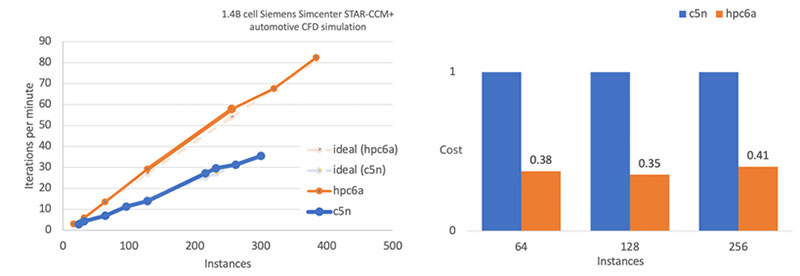A New, More-Cost-Effective Way to Run CFD in The Cloud
New purpose-built HPC instance from AWS delivers 65% better price-performance for simulations and other compute-heavy workloads.

Latest News
February 1, 2022
With physical testing being more costly and time-consuming than simulation-based testing, it’s unsurprising that computational fluid dynamics (CFD) has become so popular with design engineers – and those controlling their budgets. For organizations working in aerospace, automotive, manufacturing and other sectors, CFD applications such as Ansys Fluent, Siemens Simcenter STAR-CCM+, OpenFOAM and NASA FUN3D and OVERFLOW, play a critical role in product development processes.
As you’d expect, the drive continues to further reduce the need for physical testing, by using increasingly sophisticated CFD models. For this to happen, organizations require access to ever-greater amounts of computing power – for what is already an incredibly demanding class of workload.
The challenge of running ever-larger CFD simulations
Many engineering organizations currently run their CFD simulations on dedicated high-performance computing (HPC) clusters, hosted on-premises. But with this hardware having finite capacity, we’re hearing of more and more engineers being unable to run the size of simulations they’d like to. Others are unable to test at convenient times, due to the infrastructure being in use. These constraints hamper their aspiration to ramp down physical testing, and result in longer product development times.
Like in many other areas of computing, CFD workloads are beginning to shift to the cloud, giving engineers access to virtually limitless scale, on-demand. However, as these simulations grow to require tens of thousands of cores, cost-efficiency becomes ever-more important.
Up to 65% better price-performance
To support engineering teams in their aim to run bigger CFD models, capable of delivering increased detail and accuracy, AWS recently launched a purpose-built HPC instance, called Hpc6a.
Hpc6a is designed to support exceptionally efficient scaling, enabling the deployment of large HPC clusters within a single AWS Availability Zone. 100 Gbps inter-instance networking is provided by Elastic Fabric Adapter (EFA). Hpc6a is underpinned by the latest, third-generation AMD EPYC™ processors, with the AWS Nitro System offloading the hypervisor onto dedicated hardware, leaving the full complement of cores available to the workload.
This blend enables design engineers to run virtually any scale of simulation on-demand. Crucially, with 65% better price-performance over comparable x86-based compute-optimized Amazon Elastic Compute Cloud (EC2) instances, Hpc6a is budget-friendly too.
Organizations also have the option of running other types of AWS EC2 instance alongside Hpc6a in the same cluster, managed using AWS ParallelCluster. This gives engineers the freedom to closely align the instances they’re using with their workload requirements at any time.
AWS Hpc6a benchmarks: Testing scaling efficiency at up to 1.4 billion cells using Siemens Simcenter STAR-CCM+
The key to cost-efficiency when running large CFD workloads is linear scalability: whenever you double the number of cores, you need to achieve double the performance, even at massive scale. To test this, we benchmarked Hpc6a on various CFD applications as well as on C5n, which is a compute- and network-optimized AWS EC2 instance widely used for CFD today.
We started at the scale many engineers are currently operating at – between 100 and 200 million computational cells. However, with engineers’ aspirations to use much-more sophisticated models in mind, we also ran a 1.4-billion-cell simulation, using Siemens Simcenter STAR-CCM+ and automotive data from the DrivAer model. This test scaled to almost 400 nodes (around 40,000 cores), and showed that scaling-efficiency remained at around 100% throughout. This near-linear performance-increase as the number of instances ramped up, is shown by the graph in figure 1. The second chart compares the relative cost of Hpc6a to C5n.

Figure 1: The performance results from the Hpc6a and C5n benchmarking we ran on Siemens Simcenter STAR-CCM+, and the relative costs of the two instance types.
Opportunities to drive down software costs
The ability to scale so efficiently, even when running very large clusters, can have important benefits when it comes to software costs. Take a situation where licensing is calculated based on the number of hours the application is used. Running the model on 40,000 cores means it can complete in a quarter of the time it would take if run on 10,000 cores. While the infrastructure costs will be virtually identical in both situations, the reduced runtime on 40,000 cores will mean software costs will be just a quarter of what they would be on 10,000.
Even where software licensing is based on core counts, there can be opportunities to benefit from greater scale in the cloud. Some applications have banded licensing arrangements, meaning organizations may be able to leverage more cores in AWS than they currently have available on-premises, at the same cost. There may also be opportunities to move to the next license band, unlocking many more cores with only a modest increase in outlay.
Making a difference
Zooming out from the technical and commercial details of Hpc6a, what difference can this new instance type make for the organizations running large-scale CFD simulations?
Firstly, it removes the various constraints of on-premises infrastructure, with engineers able to run simulations at their convenience, and get results more quickly by using more cores. Both factors help teams meet – or even bring forward – project deadlines.
The second big advantage is around the high cost-efficiency. This enables product engineering functions to run the increasingly sophisticated simulations that will help reduce the need for physical testing.
Combined, these benefits have the potential to drive down both the cost and duration of development lifecycles, meaning products can ultimately be in customers’ hands more quickly, and at more-competitive prices.
Get started today
Hpc6a is available now, both US East (Ohio), and AWS GovCloud (West) Regions. Pricing can be either On-Demand, or as part of a flexible Savings Plan. Learn more, and also visit our dedicated CFD page.
More Amazon Web Services Coverage

Subscribe to our FREE magazine, FREE email newsletters or both!
Latest News







